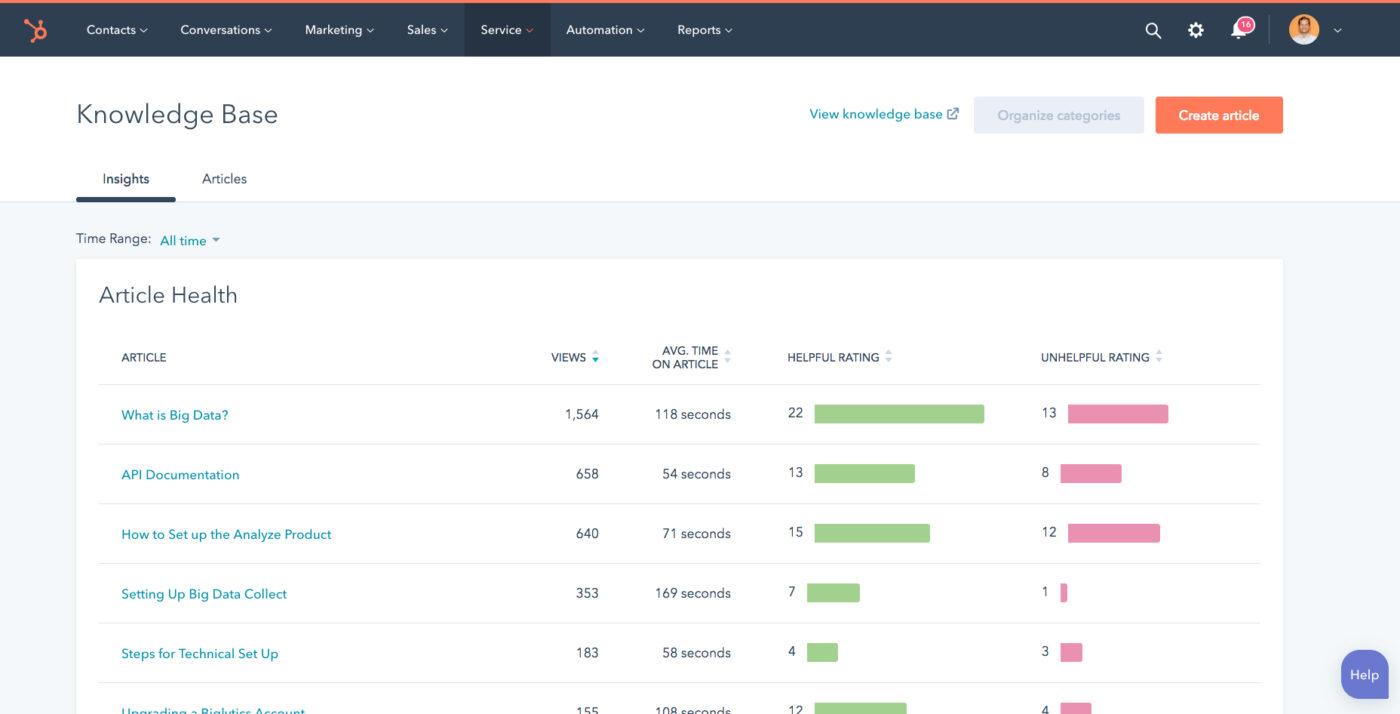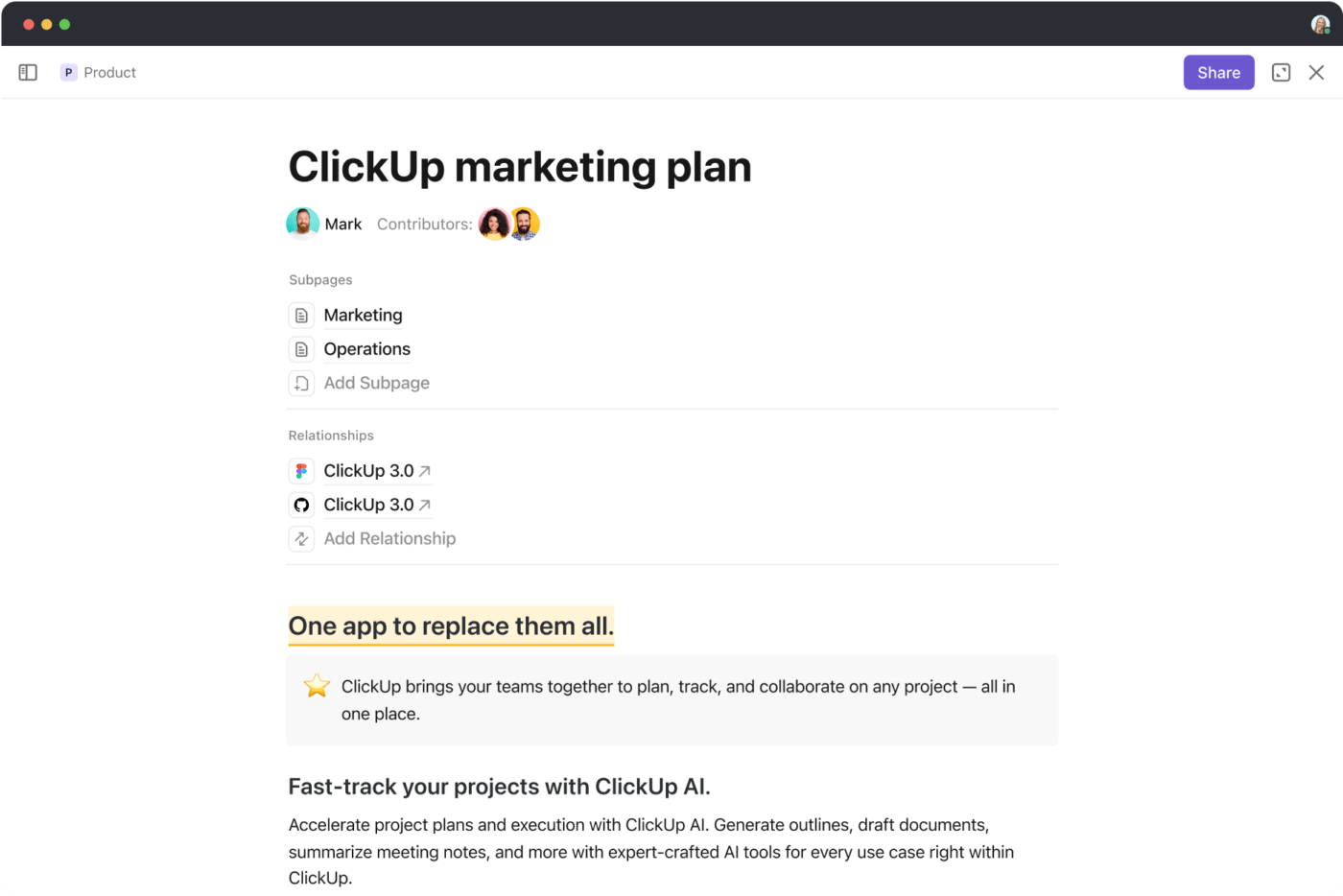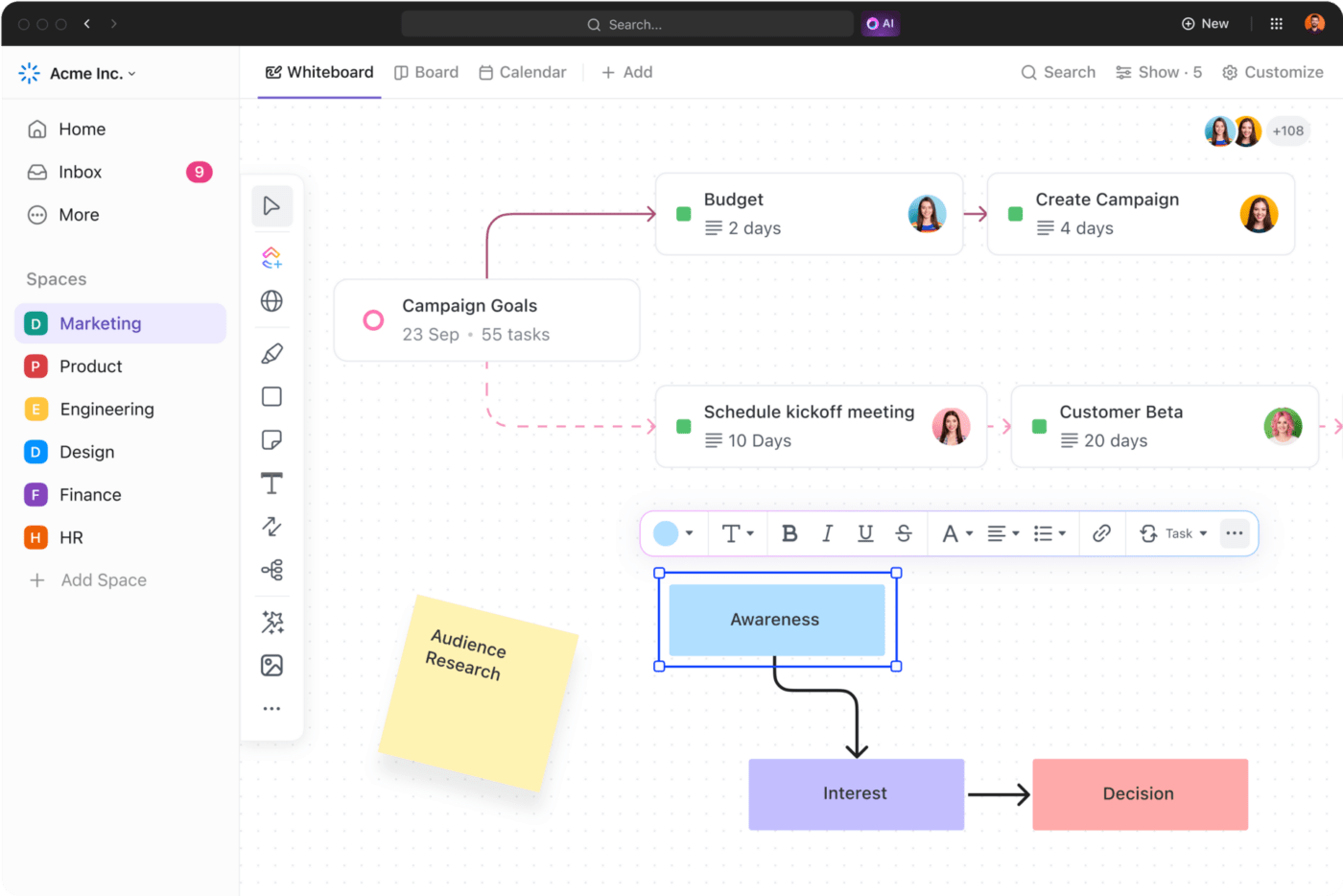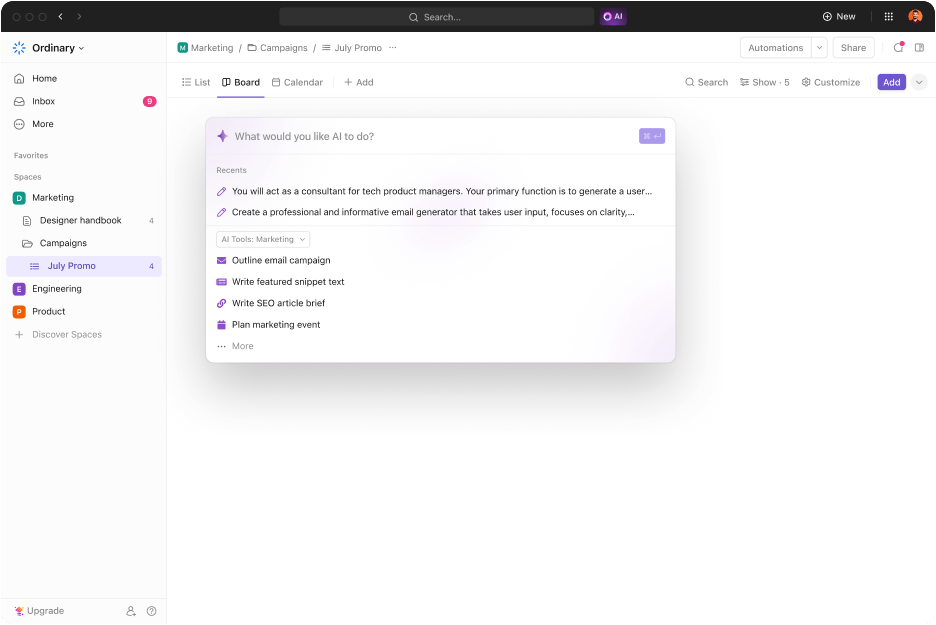أنت تعمل على مشروع مهم وتحتاج إلى العثور على الإجراء الدقيق لتقديم طلب تقديم العروض.
تبحث في مساحة عملك بالكامل في اللحظة الأخيرة، ويبدو من المستحيل تقريبًا العثور على ما تبحث عنه. هل يبدو ذلك مألوفاً؟
تحدث هذه المواقف في كثير من الأحيان. يتم تخزين معظم المعلومات المؤسسية في أنظمة منعزلة مثل المجلدات والتطبيقات المتباينة، مما يجعل من الصعب العثور على المعلومات التي تحتاجها.
ولكن ماذا لو كان لديك منظم رقمي لعقل فريقك الجماعي، مثل مكتبة منظمة بشكل جيد حيث يمكنك البحث عن المعلومات المهمة والوصول إليها بسرعة؟
هنا يأتي دور أنظمة إدارة المعرفة.
في هذه المدونة، نناقش أنظمة إدارة المعرفة وأهميتها. كما ندرج أيضاً أمثلة على أنظمة إدارة المعرفة الشائعة لنعطيك فكرة أوضح عن الحلول المتاحة وكيفية تحسينها للكفاءة التنظيمية.
فهم نظام إدارة المعرفة
يساعد نظام إدارة المعرفة المؤسسة على التقاط وتخزين ومشاركة المعرفة الصريحة (المستندات أو التقارير أو الكتيبات) والمعرفة الضمنية (الخبرات أو الرؤى الشخصية)
يعمل نظام إدارة المعرفة على تسخير المعرفة الجماعية للمؤسسة لدفع الابتكار وتحسين الكفاءة وتعزيز عملية صنع القرار. دعنا نلقي نظرة على سبب حاجتك إلى نظام إدارة المعرفة وفوائد دمجه في عمليات شركتك.
دور نظام إدارة المعرفة في سيناريوهات مختلفة
يخدم نظام إدارة المعرفة الحالات التالية:
- مركزية المعلومات: يعمل نظام إدارة المعرفة القوي كمنصة مركزية لتخزين وتنظيم أنواع مختلفة من المعلومات المؤسسية والمعرفة القيّمة
- مشاركة المعرفة: عادةً ما تحتوي هذه الأنظمة على ميزات مثل منتديات المناقشة أو مواقع الويكي التي يمكن استخدامها لإتاحة المعرفة المؤسسية عبر فرق العمل المختلفة
- التدريب والتأهيل: يمكن للموظفين الجدد الوصول إلى المقالات الإرشادية وأنظمة إدارة المحتوى والمستودع المركزي وما إلى ذلك للحصول على مواد تدريبية مفصلة. تعمل استراتيجية إدارة المعرفة المدروسة جيدًا على تسريع الوقت اللازم لتحقيق القيمة للموظفين وتسمح لهم بالوصول إلى السرعة المطلوبة
- الخدمة الذاتية: يمكن لعملائك الوصول إلى منصة إدارة المعرفة للعثور على حلول للاستفسارات بأنفسهم
فوائد نظام إدارة المعرفة
- سهولة الوصول إلى المعلومات التنظيمية المهمة، مما يساعدهم على اتخاذ قرارات مستنيرة بشكل أسرع
- تقليل الوقت المستغرق في البحث عن المعلومات وإنجاز المزيد من الأعمال
- التقاط وحفظ الرؤى والاستراتيجيات الرئيسية لضمان الاستمرارية في العمليات
- البناء على المعلومات الحالية لتحسين العمليات الحالية، ودعم التعلم المستمر، وإنشاء حلول جديدة
خصائص نظام إدارة المعرفة الجيد ## خصائص نظام إدارة المعرفة الجيد
فيما يلي بعض الميزات التي يجب مراعاتها عند اختيار نظام فعال لإدارة المعرفة.
- سهولة الاستخدام: اختر برنامج إدارة معرفة بديهي وسهل الاستخدام. فالأنظمة المعقدة تزيد من العبء المعرفي لمستخدميها، مما يؤدي في النهاية إلى توقفهم عن استخدامها
- التعاون: يوفر نظام إدارة المعرفة الصحيح ميزات التعاون مثل منتديات المناقشة والدردشة داخل التطبيق ومواقع الويكي لتشجيع مشاركة المعرفة بسلاسة
- التحليلات: توفر أدوات إعداد التقارير والتحليلات المدمجة رؤى حول استخدام النظام، ومشاركة المستخدمين، ورضا العملاء، وفعالية جهود إدارة المعرفة
- إدارة المحتوى: يجب أن يسمح النظام للمستخدمين باستخدام تنسيقات محتوى متعددة وتحميل الصور ومقاطع الفيديو والملفات الصوتية والعروض التقديمية. ابحث أيضًا عن الميزات التي تمكنك من تصنيف أنواع مختلفة من المحتوى
- البحث والاسترجاع: تتيح وظيفة البحث القوية مع الفلاتر للمستخدمين البحث عن المعلومات واسترجاعها بسهولة في نظامك المعرفي
- مدعوم بالذكاء الاصطناعي: أفضل أدوات إدارة المعرفة مدعومة الآن بوظائف الذكاء الاصطناعي والتعلم الآلي
💡 نصيحة احترافية: احرص على استخدام استراتيجية فعالة لإدارة المعرفة تتضمن مراقبة الجودة والإدارة الدقيقة للمحتوى للاستفادة من المعلومات المؤسسية بشكل جيد.
أهمية الذكاء الاصطناعي والتعلم الآلي في أنظمة إدارة المعرفة الحديثة
يلعب الذكاء الاصطناعي والتعلم الآلي دورًا رئيسيًا في تعزيز قدرة أنظمة إدارة المعرفة على التقاط المعلومات وتنظيمها.
محرك البحث المدعوم بالذكاء الاصطناعي يمكنه فهم استعلامات المستخدم بشكل أفضل، مما يحسن من ملاءمة نتائج البحث المعروضة للمستخدمين. فهو يفسر قصد المستخدم من الاستعلام من خلال تحليل كلمات مفتاحية محددة ومطابقتها مع المعلومات المتوفرة في النظام. ثم يتم عرض المحتوى الذي يطابق الكلمات المفتاحية بشكل وثيق على المستخدم.
يمكن لخوارزميات تعلّم الآلة أيضًا تحليل البيانات المتاحة ومقارنتها بالكلمات المفتاحية شائعة الاستخدام أو الاستعلامات المتكررة لتحديد أي ثغرات في المحتوى في قاعدة المعرفة. بهذه الطريقة، يمكنك إنشاء بيانات جديدة بشكل استباقي وضمان وصول الجميع إلى أحدث المعلومات.
💡 نصيحة احترافية: أدوات كتابة الذكاء الاصطناعي يمكن تكوينها لأتمتة إنشاء المحتوى، مما يضمن توثيق معلومات شركتك بسرعة ودقة.
10 أمثلة على أنظمة إدارة المعرفة
فيما يلي أفضل الخيارات إذا كنت تبحث عن أداة لإدارة المعرفة لتبسيط العمليات التنظيمية مثل التدريب والإعداد، ومركزية المعلومات لسهولة الوصول إليها، وتحسين التعاون بين أعضاء الفريق.
1. ClickUp

قم بتبسيط إدارة العمل مع إدارة المشاريع من ClickUp كليك أب هو أداة قوية شاملة لإدارة المشاريع يمكن استخدامها كنظام لإدارة المعرفة بفضل ميزاته القوية. فهو يوفر العديد من الإمكانيات لالتقاط المعلومات وتنظيمها ومشاركتها.
ميزاته متعددة الاستخدامات، مثل مستندات ClickUp و مهام النقر فوق المهام تسمح بإنشاء مواقع الويكي ومستودعات المستندات وإدارة المهام المتعلقة بالمعرفة. يمكنك تنظيم المعرفة في ClickUp Spaces والمجلدات والقوائم، مما يجعل العثور على المعلومات ذات الصلة والوصول إليها أمرًا سهلاً.
بالإضافة إلى ذلك، فإن أدوات التعاون في ClickUp، مثل دردشة ClickUp و التعليقات المعينة لتمكين الفرق من التعاون على المستندات ومشاركة الرؤى والتأكد من توافق الجميع على آخر التحديثات.
من خلال توفير مركز مركزي لمشاركة المعرفة والتعاون، يمكن لـ ClickUp تبسيط العمليات وتحسين الكفاءة وتعزيز ثقافة التعلم المستمر داخل مؤسستك.
2. SharePoint

عبر مايكروسوفت SharePoint من Microsoft عبارة عن مجموعة شاملة من أدوات إدارة المحتوى والمعرفة للمؤسسات لتمكين المؤسسات من مشاركة المعلومات وإدارتها عبر فرق العمل. ميزات مثل مكتبة المستندات والإنترانت ومرشحات البحث تسهل على المستخدمين العثور على المعلومات ذات الصلة.
3. IBM Watson

عبر آي بي إم تضم منصة IBM Watson مجموعة من الأدوات والتطبيقات المدعومة بالذكاء الاصطناعي لتبسيط عملية اكتشاف المعرفة. وتستخدم وظيفة البحث في المنصة - Watson Discovery معالجة اللغة الطبيعية لإظهار الرؤى المدفونة في أعماق مستندات الأعمال.
يحلل نظام واتسون من IBM Watson كميات كبيرة من البيانات والمحتوى لاستخراج الرؤى والأنماط المفيدة تلقائيًا.
4. مفهوم

عبر فكرة Notion هي مساحة عمل متكاملة لتدوين الملاحظات وإدارة المعرفة. تُستخدم المنصة لبناء قواعد بيانات معرفية قابلة للتخصيص مع فئات وعلامات وروابط.
تتيح ميزات مثل مساحة العمل المشتركة والتعليقات والإشارات التعاون في الوقت الفعلي وتجعله نظامًا جيدًا لإدارة المعرفة. بالإضافة إلى ذلك، يمكنك الربط بين المستندات والصفحات وقواعد البيانات بحيث تكون المعلومات في سياقها ويسهل الوصول إليها.
5. Confluence من Atlassian

عبر أطلسيان غالبًا ما تستخدم فرق المطورين Confluence من Atlassian لبناء قواعد المعرفة الداخلية وتوثيق عمليات الأعمال الهامة.
تتيح ميزات مثل التحرير المتزامن والتعليقات المضمنة والإشارات والإشعارات للفرق العمل معًا في الوقت الفعلي داخل نظام إدارة المعرفة لتوفير الوقت البحث عن المعلومات المنعزلة.
تعمل وظيفة محرك البحث على فهرسة المعلومات المتاحة حتى يتمكن المستخدمون من تحديد موقع المعلومات باستخدام سمات مختلفة مثل العنوان أو المحتوى أو العلامات.
6. المعلم

عبر المعلم المعلم هو برنامج إدارة المعرفة الذي يربط المستندات والتطبيقات والمحادثات في مصدر واحد للحقيقة. وهذا يعني أنه يمكن لفرقك البحث في المعرفة الجماعية لمؤسستك من مركز مركزي دون البحث في المعلومات المبعثرة.
يمكن استخدام ميزة البرمجة اللغوية العصبية لتحليل استعلامات المستخدم وعرض المعلومات الأكثر صلة بناءً على تفاصيل مثل الدور والموقع والنشاط السابق.
7. Helpjuice

عبر هيلب جوس إذا كنت تبحث عن حل قاعدة معرفية لتهيئة العملاء الجدد، وتمكين الخدمة الذاتية، وتدريب الموظفين، فإن Helpjuice خيار جيد. واجهته سهلة الاستخدام قابلة للتخصيص بسهولة ويمكن تخصيصها لتناسب التفضيلات الجمالية لعلامتك التجارية.
يمكن استخدام Helpjuice في دعم العملاء ومشاركة المعلومات مع الفرق الداخلية.
8. Document360

عبر المستند 360 يعد Document360 أحد أشهر أنظمة إدارة المستندات، وهو أحد أنظمة إدارة المستندات الشائعة، ويوفر ميزات متقدمة للتحرير ومشاركة المستندات. تتيح لك أداة إنشاء السحب والإفلات الخاصة به إنشاء مستودعات معرفية مخصصة تتوافق مع هوية علامتك التجارية. كما أنه يحتوي على ما يصل إلى ستة مستويات من الفئات والفئات الفرعية لتنظيم المعلومات المزدحمة وربط المقالات ذات الصلة.
9. بلوم فاير

عبر بلوم فاير يعمل نظام المشاركة المعرفية من Bloomfire على تبسيط تنفيذ واعتماد أدوات وعمليات الأعمال. فبدلاً من تنظيم المعلومات في هياكل ملفات معقدة، يمكنك استخدام ميزات إدارة المستندات في Bloomfire لتصنيف المحتوى ووضع علامات عليه والبحث عنه.
تعمل إمكانات المزامنة التلقائية على مزامنة المعلومات تلقائياً من مصادر متعددة، مما يضمن حصول المستخدمين على أحدث المعلومات وتقليل التحديثات اليدوية.
10. HubSpot

عبر هبسبوت يساعد HubSpot Service HubSpot الشركات على تحسين خدمة العملاء من خلال توفير ميزة قاعدة المعرفة لإنشاء موارد الخدمة الذاتية. يمكنك إنشاء مستودع معرفي منظم يتضمن الأسئلة الشائعة ومقالات المساعدة والأدلة الإرشادية لتقديم إجابات لاستفسارات العملاء المتكررة.
توفر ميزة التحليلات رؤى حول المقاييس الرئيسية مثل مشاركة المستخدم، وانحراف التذاكر، وأداء المقالات، واتجاهات البحث، مما يساعد على قياس فعالية قاعدة المعرفة الخاصة بك.
أنواع أنظمة إدارة المعرفة
هناك عدة أنواع مختلفة من أنظمة إدارة المعرفة، ولكل منها وظائف مختلفة. بمجرد تحديد نوع المعرفة المؤسسية التي تريد مشاركتها ومع من، يمكنك اختيار النظام المناسب من الأمثلة أدناه.
1. قاعدة المعرفة الداخلية
قاعدة المعرفة الداخلية هي نظام مصمم لمشاركة المعلومات مع موظفي المؤسسة. والهدف من ذلك هو تنظيم وإدارة جميع معلومات الشركة المهمة في موقع واحد حتى تتمكن الفرق من الوصول إليها عند الحاجة.
يمكن للموظفين العمل بكفاءة أكبر مع إمكانية الوصول السريع إلى سياسات الشركة وإجراءاتها وكتيباتها وغيرها من الوثائق الهامة. أكبر فائدة لقاعدة المعرفة الداخلية هي أن أعضاء الفريق في جميع أنحاء المؤسسة يستخدمون نفس الموارد المحدثة.
تعمل قاعدة المعرفة الداخلية الشاملة أيضًا كبوابة للخدمة الذاتية للموظفين، مما يقلل من حاجة الفرق إلى التواصل مع الموارد البشرية أو تكنولوجيا المعلومات أو الأقسام الأخرى لتوضيح الاستفسارات المتكررة.
💡 نصيحة احترافية: استخدم قالب كتيبات وسياسات وإجراءات الموظفين في ClickUp لإنشاء مورد معرفي داخلي شامل لإنشاء وإدارة الوثائق الموجهة للموظفين. وهو يوفر إطارًا منظمًا يغطي موضوعات أساسية مثل معلومات الشركة، وحقوق الموظفين ومسؤولياتهم، والتعويضات والمزايا، وإدارة الأداء، وغير ذلك.
قالب كتيبات وسياسات وإجراءات الموظفين من ClickUp
2. قاعدة المعرفة الخارجية
استخدم قاعدة معرفة خارجية لمشاركة المعلومات مع أصحاب المصلحة خارج مؤسستك، مثل الشركاء أو البائعين أو العملاء.
وهي بمثابة مركز حيث يمكن لأي شخص خارج مؤسستك الوصول إلى الموارد المهمة دون الاتصال بفريق الدعم في شركتك. يمكن أن تتضمن قاعدة المعرفة الخارجية وثائق المنتج، والأسئلة الشائعة، وأدلة استكشاف الأخطاء وإصلاحها، وتحديثات المنتج، وحتى وثائق واجهة برمجة التطبيقات.
يمكن الوصول إلى قواعد المعرفة الخارجية على مدار الساعة طوال أيام الأسبوع، مما يسهل على المستخدمين العثور على إجابات للاستفسارات بشكل مستقل. وهذا يحسّن تجربة المستخدم ويقلل من عبء العمل على فريق الدعم لديك
💡 نصيحة احترافية: يمكنك إنشاء مستندات خارجية ونشرها باستخدام مستندات ClickUp Docs عبر رابط يمكن الوصول إليه بشكل عام.

كتابة سياسات الشركة الخارجية وتحريرها ونشرها باستخدام ClickUp Docs
3. أنظمة إدارة التعلم
يتيح لك نظام إدارة التعلم إنشاء المحتوى التعليمي وإدارته وتقديمه للجمهور الذي تريده. تستخدم معظم المؤسسات نظام إدارة التعلم لتسهيل التدريب المؤسسي والتطوير المهني. فهي تقسم الدورات التدريبية المعقدة إلى وحدات أصغر حجمًا لتكون سهلة الهضم.
يمكن للمدرسين إنشاء مواد تدريبية بتنسيقات متعددة، مثل مقاطع الفيديو والاختبارات والعروض التقديمية والعروض التقديمية والواجبات. يمكن للمتعلمين الوصول إلى تنسيقات المحتوى التي تناسب أسلوبهم في التعلم.
تحتوي معظم أنظمة إدارة التعلم على تحليلات مدمجة تسمح للمدربين بتتبع فعالية محتوى الدورة التدريبية. يمكن أن يمنحك تحليل المقاييس مثل معدلات إكمال الدورة التدريبية والوقت المستغرق في الحصول على القيمة الأولى ومشاركة المستخدم رؤى حول نوع المحتوى التدريبي الذي يعمل بشكل أفضل وما يحتاج إلى تحسين.
يمكن أيضًا استخدام ClickUp Docs لإنشاء مستندات منظمة ومنسقة منطقيًا لتدريب الموظفين وتأهيلهم. يمكنك تحديد الأهداف باستخدام أهداف ClickUp لتتبع التقدم المحرز في التعلم ومراقبة إكمالها.
4. أنظمة إدارة الوثائق
لنفترض أن عملك يتعامل مع كميات كبيرة من المستندات مثل العقود أو الاتفاقيات أو النماذج أو مذكرات القضايا. مع تزايد عدد هذه المستندات، ستحتاج إلى نظام مركزي لتنظيم هذه الملفات وتحريرها وإدارتها. هذا هو المكان الذي ستجد فيه حل إدارة المستندات مفيداً.
إن نظام إدارة المستندات، أو حل إدارة المستندات، هو نظام لـ تحميل وتخزين وتصنيف المستندات الإلكترونية. وعادةً ما توفر هذه الأنظمة وظائف بحث واسترجاع قوية وعناصر تحكم في الوصول وبروتوكولات تشفير لحماية البيانات الحساسة. تمكّن ميزات التعاون القوية الفرق من مشاركة المستندات وإضافة التعليقات وترك الملاحظات لضمان سلاسة العمل الجماعي على الملفات المشتركة.
كما توفر بعض حلول إدارة المستندات أيضًا ميزات أتمتة سير العمل لأتمتة المهام الروتينية مثل الموافقات على المستندات والإشعارات وتعيين المهام.
5. الإنترانت
غالبًا ما تستخدم الشركات الكبيرة أو شركات الرعاية الصحية أو الشركات التي لديها مواقع متعددة وفرق عمل عن بُعد شبكة إنترانت لمشاركة المعلومات ومركزية التواصل وتمكين التعاون.
تشبه شبكة الإنترانت إلى حد كبير شبكة الإنترنت، ولكنها شبكة خاصة تقتصر على الموظفين داخل المؤسسة. وهي تقدم ميزات مثل موجزات الأخبار والإعلانات، حيث يمكنك نشر تحديثات على مستوى الشركة حتى يبقى الجميع على اطلاع دائم
يمكن للموظفين استخدام الإنترانت للوصول إلى الموارد الداخلية (الدلائل وسياسات الشركة وكتيبات الموظفين وبوابات تكنولوجيا المعلومات والموارد البشرية) والتعاون في المشاريع باستخدام وظائف التعاون مثل منتديات المناقشة والمحادثات.
6. منصات التعاون
تساعد أدوات التعاون الفرق في المؤسسة على العمل معًا ومشاركة المعلومات والتحديثات المهمة. يمكن للفرق مشاركة المعرفة على الفور من خلال الرسائل المباشرة أو المجموعات أو القنوات لحل المشاكل في الوقت الفعلي.
كما توفر معظم هذه الأدوات أيضاً ميزات للمكالمات الصوتية ومؤتمرات الفيديو، وهو أمر مفيد للغاية في كسر صوامع الأقسام وتشجيع التعاون بين مختلف الوظائف.
7. أنظمة إدارة المحتوى
يمكن استخدام نظام إدارة المحتوى لإنشاء محتوى رقمي على المواقع الإلكترونية وتحريره ونشره. ميزة أنظمة إدارة المحتوى هي أنه حتى المستخدمين غير التقنيين (غير الملمين بالترميز أو البرمجة) يمكنهم بسهولة استخدام المحررين المدمجين فيها لإنشاء المحتوى وتنسيقه.
ويمكنك تحديث المحتوى بسرعة، وتحميل ملفات الوسائط المتعددة لإضافة السياق، واستخدام المنصة لمشاركة المعرفة مع الجمهور العام.
8. منتديات المجتمع عبر الإنترنت
المنتدى المجتمعي هو عبارة عن منصة يمكن للمستخدمين والمؤسسات من خلالها مشاركة خبراتهم ورؤاهم ومعارفهم حول موضوع معين. يمكن للمستخدمين التحدث إلى أعضاء المجتمع الآخرين واستخدام المعرفة الجماعية للمنتدى لإيجاد حلول للمشاكل المشتركة. وبمرور الوقت، يمكن أرشفة هذه المناقشات لإنشاء قاعدة معرفية قابلة للبحث تعالج الأسئلة الشائعة.
رديت، وكورا، وديسكورد هي الأمثلة الأكثر شيوعًا لمثل هذه المنتديات المجتمعية.
9. أنظمة إدارة القرار
تمكّن أنظمة إدارة القرار المؤسسات من جمع كل بياناتها الحالية من مصادر متعددة في منصة واحدة. ويمكن استخدام هذه الرؤى، بالاقتران مع تحليلات الأعمال، لتبسيط عملية اتخاذ القرار في الشركة.
يمكن لأنظمة إدارة القرار تحليل كميات هائلة من البيانات بسهولة وتحديد الأنماط المتكررة وتأثيرها على نمو الأعمال.
يتكون نظام إدارة القرار عادةً من محرك قواعد الأعمال الذي يخبرك كيف ينبغي إجراء عمليات تشغيلية معينة. وغالبًا ما تتميز بميزات التحليلات التنبؤية التي يمكنها التنبؤ بالأحداث المستقبلية بناءً على الأنماط الحالية.
بعد ذلك، لديك ميزات وأدوات إعداد التقارير في الوقت الفعلي للاختبار والمحاكاة، والتي تتيح لك دراسة تأثير القرارات والقواعد المختلفة قبل تطبيقها على سيناريوهات العالم الحقيقي.
10. الأنظمة الخبيرة
النظام الخبير هو حل مدعوم بالذكاء الاصطناعي يجمع بين قوة قاعدة المعرفة وما نسميه "محرك الاستدلال" يحتوي مكون القاعدة المعرفية على معلومات محددة للغاية مبنية من خبرات المتخصصين البشريين.
يقوم محرك الاستدلال بمعالجة المعلومات من قاعدة المعرفة ليقدم لك إجابات للمشاكل المعقدة. يمكن للشركات استخدام الأنظمة الخبيرة للحصول على توصيات وأفضل الممارسات في مجالات مثل الطب أو الهندسة أو التمويل.
على سبيل المثال، يمكن أن تكون الأنظمة الخبيرة مفيدة في تشخيص الحالات الطبية، وتقييم مخاطر الائتمان، وتحليل المستندات القانونية، وحل المشكلات التقنية.
قراءة المزيد: أفضل 10 أدوات لإدارة المعرفة بالذكاء الاصطناعي
تنفيذ نظام إدارة المعرفة باستخدام ClickUp منصة إدارة المعرفة في ClickUp توفر ميزات قوية توفر المرونة اللازمة لإدارة جوانب متعددة من إدارة المعرفة، مثل التوثيق الداخلي والتعاون وإنشاء المحتوى وغير ذلك.

أنشئ مستودعًا مركزيًا قويًا باستخدام مركز إدارة المعرفة من ClickUp
باعتبارها منصة قاعدة معرفية للمؤسسة، يُعد ClickUp مركزًا مركزيًا لتنظيم أنواع مختلفة من المعلومات ليتمكن الجميع من الوصول إليها، بدءًا من أعضاء فريقك الداخلي وحتى العملاء.
إليك كيفية استخدام ClickUp لتنفيذ أنظمة إدارة المستندات في مؤسستك.
1. إنشاء المعرفة
يمكنك استخدام مستندات ClickUp لإنشاء مستندات مفصلة حول سياسات الشركة وأفضل الممارسات وسير عمل المشروع.
تسمح لك ميزات مثل الصفحات المتداخلة وخيارات التصميم المبنية مسبقًا بتقسيم المعلومات المعقدة إلى أجزاء يمكن التحكم فيها وتنسيقها بشكل منطقي. يمكن للمستخدمين الغوص بسهولة في الأقسام التي يريدونها دون أن يغرقوا في الكثير من المعلومات دفعة واحدة.

استخدم ClickUp Docs لإنشاء معلومات المؤسسة وإدارتها للاستخدام الداخلي والخارجي
ادعُ أعضاء الفريق للتعاون في المستندات في الوقت الفعلي، وترك التعليقات، وإضافة رؤاهم. يمكنك حتى استخدام @mentions للإشارة إلى أعضاء فريق محددين وتعيين عناصر عمل لهم مباشرةً من داخل المستند.
على سبيل المثال، بالنسبة لقواعد معارف دعم العملاء، يمكنك إنشاء مستندات متعددة لمواضيع مختلفة وتنظيمها في مركز المستندات بحيث يسهل العثور عليها.
💡 نصيحة احترافية: إنشاء ويكي الشركة لتجميع معلومات الشركة الداخلية، والسماح للفرق بالمساهمة بخبراتهم الجماعية، وكسر حاجز المعلومات.
2. بحث مبتكر
مكِّن فرقك من العثور على المعلومات من داخل ClickUp أو من تطبيق متصل أو من محرك الأقراص المحلي باستخدام ClickUp Universal Search . يوفر طريقة سريعة لإظهار أي رؤى متعلقة بالعمل تقريبًا بغض النظر عن مكان تخزينها داخل نظامك.

البحث بسهولة عن المعلومات المبعثرة عبر أنظمة متعددة باستخدام ميزة ClickUp Universal Search
أفضل ما في الأمر أنه يمكنك إنشاء أمر بحث مخصص لمساعدتك في تحديد موقع معلومات معينة. على سبيل المثال، أنشئ اختصارات للروابط التي يتم فتحها بشكل متكرر أو احفظ أجزاء معينة من النص (ملاحظات، أو أفكار، أو مقتطفات أخرى من المعلومات) واستردها لاحقًا.
الميزة الأهم للبحث الشامل هي أنه يجمع بين المعلومات المخزنة في أنظمة منعزلة ويجعلها في متناول الجميع في مؤسستك على الفور.
3. التعاون
تبسيط تواصل الفريق في الوقت الفعلي مع ClickUp Chat . تفتح نافذة الدردشة مباشرةً إلى جانب مساحة العمل الخاصة بك، مما يعني أنك لست مضطرًا للتبديل بين التطبيقات لبدء المحادثات مع أعضاء الفريق.
ما عليك سوى استخدام @الإشارات لدعوة زميل في الفريق للدردشة أو مشاركة التحديثات أو تعيين عناصر الإجراءات مباشرةً داخل المحادثة.

تعاون مع أعضاء الفريق في الوقت الفعلي باستخدام ClickUp Chat
إذا كنت تريد لوحة رقمية لتبادل الأفكار مع فريقك عن بُعد, كليك أب السبورات البيضاء تأتي لإنقاذك
يمكن لفرقك مشاركة الأفكار وشرح المفاهيم بصرياً. أضف الملاحظات وحمّل الصور وضمّن الروابط لـ إضافة أكبر قدر ممكن من السياق لأفكارك. استخدم الروابط لإنشاء روابط بين الأفكار وإظهار كيفية ترابط الموضوعات المختلفة.
بمجرد الانتهاء من أفكارك، قم بتحويلها إلى مهام قابلة للتتبع من السبورة البيضاء لضمان إكمالها في الوقت المحدد.

قم بالعصف الذهني مع أعضاء فريقك على لوحة رقمية باستخدام لوحات ClickUp Whiteboards
4. إجابات فورية
إذا كنت تريد طريقة أسهل للبحث عن معلومة ما, انقر فوق الدماغ هو إجابتك. وهو يعمل كمدير للمعرفة يعمل بالذكاء الاصطناعي ويعرض رؤى من أي مهام أو مستندات أو مشاريع متصلة ب ClickUp كلما طرحت سؤالاً متعلقاً بالعمل.

استخدم ClickUp Brain للمساعدة في إنشاء معلومات المشروع وتلخيص ملاحظات الاجتماع والمزيد
ClickUp Brain يعمل على أتمتة المهام المتكررة مثل إرسال تحديثات المشروع إلى أعضاء الفريق، وتغيير حالة المهام، وتلخيص تقارير وملاحظات الاجتماعات. وبهذه الطريقة، يمكن لفرقك التركيز على العمل المهم وتقليل الوقت المستغرق في المهام الزائدة عن الحاجة.
💡 نصيحة احترافية: استخدم قوالب دليل الموظف لإنشاء سياسات موارد بشرية شاملة ومكتوبة بشكل جيد ومتوافقة مع القانون وسهلة الفهم.
5. قوالب معدة مسبقاً
يقدم ClickUp مكتبة واسعة من القوالب المعدة مسبقًا لحالات استخدام متعددة. وهذا يعني أنك لست مضطرًا للبدء من الصفر في كل مرة تحتاج فيها إلى إنشاء مستند أو عملية أو خطة مشروع جديدة.
لا توفر الوقت فحسب، بل تحافظ أيضًا على الاتساق بين المهام.
على سبيل المثال، فإن قالب قاعدة المعارف ClickUp هو إطار عمل قابل للتخصيص لإنشاء وتنظيم المعلومات المهمة. يحتوي على أقسام محددة مسبقًا للأسئلة الشائعة وأدلة المنتجات والسياسات وغيرها.
قالب قاعدة المعرفة الخاص بـ ClickUp
باستخدام هذا القالب، يمكنك
- إنشاء ومشاركة معلومات مصممة خصيصًا لاحتياجات مؤسستك وسير العمل الخاصة بها
- تنظيم المعلومات تحت فئات ومجلدات مختلفة بحيث يسهل العثور عليها
- تتبع حالة تحديثات المستندات
- التحكم في من يمكنه عرض وتحرير قاعدتك المعرفية
وبالمثل، استخدم قالب قالب ويكي الشركة لتنظيم معلومات الشركة مثل الرسالة والقيم الأساسية للمؤسسة، وكتيبات الموظفين، وموارد التطوير الوظيفي، وسياسات النفقات. إنها الطريقة المثلى لضمان توافق الجميع في الشركة مع العمليات والإجراءات الهامة.
قالب ويكي شركة ClickUp
باستخدام هذا القالب، يمكنك
- تبسيط عملية الإعداد وإدارة المعرفة للموظفين الجدد وجعلهم على دراية بسرعة
- التعاون مع أصحاب المصلحة لضمان أن تكون المعلومات ثاقبة ودقيقة
- تنظيم المعرفة حسب الفئات مثل سياسات الموارد البشرية، ومعلومات الأقسام، وأدلة التأهيل، والمزيد
- قم بتضمين الصور ومقاطع الفيديو والروابط لجعل المستند أكثر ملاءمة لسياق أعضاء الفريق
بالإضافة إلى ذلك، يمكنك إنشاء تعليمات البدء السريع وتوفير أساس متين لأي شخص في فريقك لإنشاء قاعدة معرفية باستخدام قالب ClickUp Wiki . إنه قالب مرن يمكن تخصيصه حسب تصميم علامتك التجارية والتأكد من أن فرقك على اطلاع دائم بالمواضيع المهمة.
اقرأ المزيد: قوالب قاعدة المعرفة المجانية في Word & ClickUp
6. قواعد البيانات
بالإضافة إلى ذلك، يمكنك إنشاء قواعد بيانات في ClickUp باستخدام القوائم والمجلدات. يساعدك هذا على تخزين أنواع مختلفة من المعلومات واستخدام حقول مخصصة لالتقاط سمات مثل معلومات الاتصال والتواريخ والميزانيات والتقييمات والروابط وغيرها.
يتيح ذلك لزملائك في الفريق استرجاع المعلومات ذات الصلة من قاعدة البيانات بسرعة وسهولة.
7. التحكم في الإصدار
أحد أهم جوانب إدارة المعرفة هو فهم كيفية تطور المحتوى في هذه الأنظمة.
يوفر ClickUp التحكم في الإصدار، والذي يتيح لك تتبع التغييرات ومراجعة الإصدارات التاريخية للمستند. ويحتفظ بسجل تدقيق يمكّنك من معرفة من قام بالتغييرات ومتى تم إجراؤها - للحفاظ على دقة المعلومات وشفافيتها.
تبسيط إدارة المعرفة باستخدام ClickUp
إدارة المعرفة هي عملية شاملة تضمن كفاءة مؤسستك وعمليات الأعمال بشكل عام.
يجب عليك اختيار نظام إدارة المعرفة الذي يلبي الاحتياجات والتفضيلات المحددة لمؤسستك.
يبرز ClickUp كحل ممتاز لإدارة المعرفة لأنه يمكن أن يكون بمثابة قاعدة معرفية داخلية وخارجية.
تضمن لك ميزات مثل مساعد الذكاء الاصطناعي المدمج، والتوثيق التعاوني، وإدارة المهام، والتحكم في الإصدار، والبحث الشامل، أن المعلومات القيمة متاحة باستمرار لموظفيك متى احتاجوا إليها. اشترك في ClickUp مجاناً لبناء نظام إدارة معرفة بديهي لمؤسستك.




